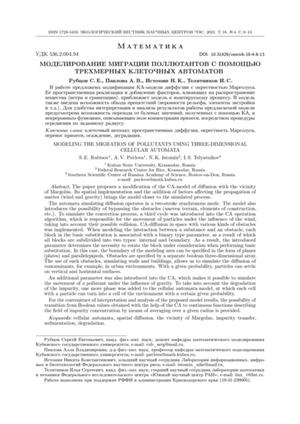Моделирование миграции поллютантов с помощью трехмерных клеточных автоматов
УДК
536.2:004.94EDN
EILBFTDOI:
10.31429/vestnik-18-4-8-13Аннотация
В работе предложена модификация КА-модели диффузии с окрестностью Марголуса. Ее пространственная реализация и добавление факторов, влияющих на распространение вещества (ветра и гравитации) приближает модель к имитируемому процессу. В модель также введена возможность обхода препятствий (неровности рельефа, элементы застройки и т.д.). Для удобства интерпретации и анализа результатов работы предлагаемой модели предусмотрена возможность перехода от булевых значений, полученных с помощью КА, к непрерывным функциям, описывающим поле концентрации примеси, посредством процедуры осреднения по заданному радиусу.
Ключевые слова:
клеточный автомат, пространственная диффузия, окрестность Марголуса, перенос примеси, осаждение, деградацияИнформация о финансировании
Работа выполнена при поддержке РФФИ и администрации Краснодарского края (19-41-230005).
Библиографические ссылки
- Алоян А.Е. Моделирование динамики и кинетики газовых примесей и аэрозолей в атмосфере. М.: Наука, 2008. 415 с. [Aloyan A.E. Modelirovanie dinamiki i kinetiki gazovykh primesey i aerozoley v atmosfere [Modeling the dynamics and kinetics of gaseous impurities and aerosols in the atmosphere]. Nauka, Moscow, 2008. (In Russian)]
- Пененко В.В., Алоян А.Е. Модели и методы для задач охраны окружающей среды. Новосибирск: Наука, 1985. 245 с. [Penenko V.V., Aloyan A.E. Modeli i metody dlya zadach okhrany okruzhayushchey sredy [Models and methods for environmental protection problems]. Nauka, Novosibirsk, 1985. (In Russian)]
- Bandman O.L. A method for construction of cellular automata simulating pattern formation processes // Theoretical background of applied discrete mathematics. 2010. No. 4. P. 91–99.
- Бандман О.Л. Отображение физических процессов на их клеточно-автоматные модели // Вестник томского государственного университета. 2008. № 2(3). C. 5–17. [Bandman O.L. Otobrazhenie fizicheskikh protsessov na ikh kletochno-avtomatnye modeli [Mapping physical processes on their cellular automata models]. Vestnik tomskogo gosudarstvennogo universiteta [Bulletin of the Tomsk State University], 2008, no. 2(3), pp. 5–17. (In Russian)]
- Алексеев Д.В., Казунина Г.А., Чередниченко А.В. Клеточно-автоматное моделирование процесса разрушения хрупких материалов // Прикладная дискретная математика. Дискретные модели реальных процессов. 2015(a). № 2 (28). С. 103–117. [Alekseev D.V., Kazunina G.A., Cherednichenko A.V. Kletochno-avtomatnoe modelirovanie protsessa razrusheniya khrupkikh materialov [Cellular-automatic modeling of the process of destruction of brittle materials]. Prikladnaya diskretnaya matematika. Diskretnye modeli real'nykh protsessov [Applied Discrete Mathematics. Discrete models of real processes], 2015(a), no. 2 (28), pp. 103–117. (In Russian)]
- Беланков А.Б., Столбов В.Ю. Применение клеточных автоматов для моделирования микроструктуры материала при кристаллизации // Сиб. журн. индустр. матем. 2005. № 8:2. C. 12–19. [Belankov A.B., Stolbov V.Yu. Primenenie kletochnykh avtomatov dlya modelirovaniya mikrostruktury materiala pri kristallizatsii [Application of cellular automata for modeling the microstructure of a material during crystallization]. Sibirskiy zhurnal industrial'noy matematiki [Siberian Journal of Industrial Mathematics], 2005, no. 8:2, pp. 12–19. (In Russian)]
- Рубцов С.Е., Павлова А.В. Клеточно-автоматные модели диффузионно-реакционных процессов многокомпонентных примесей // Защита окружающей среды в нефтегазовом комплексе. 2016. № 6. С. 55–60. [Rubtsov S.E., Pavlova A.V. Kletochno-avtomatnye modeli diffuzionno-reaktsionnykh protsessov mnogokomponentnykh primesey [Cellular-automatic models of diffusion-reaction processes of multicomponent impurities]. Zashchita okruzhayushchey sredy v neftegazovom komplekse [Environmental protection in the oil and gas complex], 2016, no. 6, pp. 55–60. (In Russian)]
- Chopard B., Droz M. Cellular automata model for heat conduction in a fluid // Physical Letters A. 1988. Vol. 126. No. 8/9. P. 476–480.
- Weimar J. Cellular automata for reaction/diffusion systems // Parallel Computing. 1997. Vol. 23. No 11. P. 1699–1715.
- Маглинейкий Г., Степанцов М. Клеточные автоматы для расчета некоторых газодинамических процессов // Журнал вычислительной математики и математической физики. 1996. Т. 36. № 5. С. 137–145. [Maglineykiy G., Stepantsov M. Kletochnye avtomaty dlya rascheta nekotorykh gazodinamicheskikh protsessov [Cellular automata for calculating some gas-dynamic processes]. Zhurnal vychislitel'noy matematiki i matematicheskoy fiziki [Journal of Computational Mathematics and Mathematical Physics], 1996, vol. 36, no 5, pp. 137–145. (In Russian)]
- Свирежев Ю.М. Нелинейные волны, диссипативные структуры и катастрофы в экологии. М.: Наука, 1987. 368 с. [Svirezhev Yu.M. Nelineynye volny, dissipativnye struktury i katastrofy v ekologii [Nonlinear waves, dissipative structures and catastrophes in ecology]. Nauka, Moscow, 1987. (In Russian)]
- Аладьев В.З. Классические однородные структуры. Клеточные автоматы. Fultus Books. CA, Palo Alto, 2009. 535 с. [Alad'ev V.Z. Klassicheskie odnorodnye struktury. Kletochnye avtomaty [Classic homogeneous structures. Cellular automata]. Fultus Books. CA, Palo Alto, 2009. (In Russian)]
- Матюшкин И.В., Заплетина М.А. Обзор по тематике клеточных автоматов на базе современных отечественных публикаций // Компьютерные исследования и моделирование. 2019. Т. 11. № 1. С. 9–57. [Matyushkin I.V., Zapletina M.A. Obzor po tematike kletochnykh avtomatov na baze sovremennykh otechestvennykh publikatsiy [Review on the topic of cellular automata based on modern domestic publications]. Komp'yuternye issledovaniya i modelirovanie [Computer Research and Modeling], 2019, vol. 11, no. 1, pp. 9–57. (In Russian)]
- Бандман О.Л. Инварианты клеточно-автоматных моделей реакционно-диффузионных процессов // Прикладная дискретная математика. 2012. № 3(17). С. 108–120. [Bandman O.L. Invarianty kletochno-avtomatnykh modeley reaktsionno-diffuzionnykh protsessov [Invariants of cellular automata models of reaction-diffusion processes]. Prikladnaya diskretnaya matematika [Applied discrete mathematics], 2012, no. 3(17), pp. 108–120. (In Russian)]
- Кочкин Н.С., Павлова А.В., Рубцов С.Е. Клеточно-автоматное и конечно-разностное моделирование процесса миграции примеси // Актуальные проблемы прикладной математики, информатики и механики: труды Международной конференции. Воронеж: Научно-исследовательские публикации, 2020. С. 950–953. [Kochkin N.S., Pavlova A.V., Rubtsov S.E. Kletochno-avtomatnoe i konechno-raznostnoe modelirovanie protsessa migratsii primesi [Cellular-automatic and finite-difference modeling of the process of migration of impurities]. Aktual'nye problemy prikladnoy matematiki, informatiki i mekhaniki: trudy Mezhdunarodnoy konferentsii [Actual problems of applied mathematics, informatics and mechanics: proceedings of the International conference]. Nauchno-issledovatel'skie publikatsii, Voronezh, 2020, pp. 950–953. (In Russian)]
Скачивания

Даты
Поступила в редакцию
Принята к публикации
Публикация
Как цитировать
Лицензия
Copyright (c) 2022 Рубцов С.Е., Павлова А.В., Истомин Н.К., Телятников И.С.

Это произведение доступно по лицензии Creative Commons «Attribution» («Атрибуция») 4.0 Всемирная.


